Abstract
In Republic of Kazakhstan live more than 130 ethnoses. In this regard social and psychological research of interethnic intensity represents special relevance for the multiethnic state. The category of "ethnic tensions" does not contain negative and evaluative sense; it also includes the psychological states and processes, the prevalence of different constructive focus on inter-ethnic relations. Research objective – to study system of the social and psychological indicators defining degree of interethnic intensity. Research was conducted on the basis of the Kazakh national university of al-Farabi.We used J. Finni's technique – Soldatova "Types of ethnic identity", modified by Aymaganbetova the technique of a social distance of E. Bogardus modified by Pochebut Soldatova's an express questionnaire the "Tolerance index", and also the test for identification of type and degree of aggression of Pochebut. In research captured 100 students - representatives of the Kazakh and Uigur ethnoses. The received results of research showed that for them domination of positive ethnic identity (56% and 56,5%), the level of ethnic indifference (20% and 24%) is high, on the third position ethnoegoism (15% and 10%) is presented. The smallest expressiveness received ethnonihilism and an etnoizolyatsionalizm. Thus, results of the conducted research showed existence at representatives of the Kazakh and Uigur ethnos of a positive orientation on interethnic interaction. However it is impossible to deny existence of separate manifestations of intra group favoritism at the ethnic level, and also existence of interethnic discrimination in some representations in favor of own ethnic group.
Keywords: Interethnic interaction, Interethnic intensity, Interethnic conflict
1.Introduction
The problem of studying the ethnic tensions has special significance today in connection with the civil war in Ukraine, the growing tension between Russia and the West, protracted interethnic and interreligious conflicts in some Arab countries make the study more than actual.
On the background of all these events there is representation of modern Kazakhstan State carrying out radical socio-economic and political reform in peace, the implementation of which is impossible without strengthening political stability and national unity, without inter-ethnic understanding and cooperation of all ethnic groups living in the countries.
Nevertheless, the apparent stability of interethnic relations existing today in the Republic of Kazakhstan shall not contribute ignoring those studies which focus on the problem of ethnic tensions and conflicts.
In this regard, the socio-psychological study of ethnic tensions in the context of the application of experimental research has particular relevance and importance.
We proceeded from the understanding that ethnic tensions - a certain level of psychological tension that is inherent in any society, regardless of its policy or monoethnicity; ethnic tension has no such negative content as a conflict and can be realized in a society where adequately represented both positive and negative identities, both positive and negative stereotypes (Aymaganbetova, 2010).
2.Problem Statement
In Republic of Kazakhstan live more than 130 ethnoses. In this regard social and psychological research of interethnic intensity represents special relevance for the multiethnic state.
3.Research Questions
The category of "ethnic tensions" does not contain negative and evaluative sense; it also includes the psychological states and processes, the prevalence of different constructive focus on inter-ethnic relations.
4.Purpose of the Study
Research objective – to study system of the social and psychological indicators defining degree of interethnic intensity. Research was conducted on the basis of the Kazakh national university of al-Farabi.
5.Research Methods
5.1Theoretical methods
Analysis and generalization of social-psychological literature on the study
5.2Empirical Methods
Questionnaires methods. Psychodiagnostic methods: the method "Types of ethnic identity" Fini and Soldatova (2010), modified by Aymaganbetova; modified technique of social and ethnocultural distance Bogardus & Pochebut (2012).
5.2.1 The empirical base of research
The study was conducted from 2012 to 2013. The study involved 100 students of the Faculty of Law and the Faculty of Philosophy and Political Science at Al-Farabi Kazakh National University - The survey covered 50 students - representatives of the Kazakh ethnic group and 50 students - representatives of the Uighur ethnic group.
5.3Methods of mathematical statistics
Methods of descriptive statistics, nonparametric tests (U-Mann-Whitney test), correlation analysis (Kendall's rank correlation coefficient). The calculations are performed using the computer program Microsoft Excel and SPSS 16.0 for Windows.
6.Findings
In research captured 100 students - representatives of the Kazakh and Uigur ethnoses. The received results of research showed that for them domination of positive ethnic identity (56% and 56,5%), the level of ethnic indifference (20% and 24%) is high, on the third position ethnoegoism (15% and 10%) is presented. The smallest expressiveness received ethnonihilism and an etnoizolyatsionalizm.
In examining the types of ethnic identity characteristics of the Kazakh and Uighur ethnic groups, data were obtained, which are presented in Figure 1 and 2:
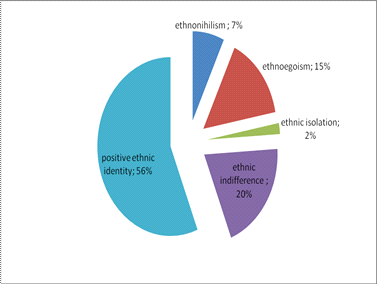
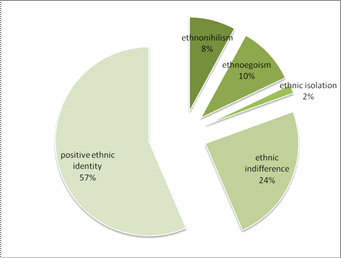
As it seems at the figures students typical dominance of positive ethnic identity, which determines the level of norms of ethnic identity (56% and 56.5% respectively), a fairly high level of ethnic indifference (20% and 24%) believes that his people no better and no worse than other people, in third position in the expression represented ethno egotism (15% and 10%) - an exaggerated desire for positive ethnic identity. And finally, the lowest severity among the students received this type of ethnic identity as ethno nihilism (7% and 8%) - leveling the ethnic factor in social life and ethno izotsionalizm (2% and 1.5%), which manifests itself as a form of xenophobia, which asserts principles of purism ("purity" of the ethnic group).
Next, we summarize the data obtained by the type of ethnic identity, and according to the procedure examined the distribution of ethnic identity on the three rails - norm of ethnic identity, and hyper identity hypo identity. The results are shown in Figure 3 and 4.

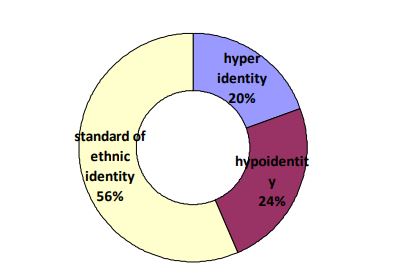
Level standards of ethnic identity is characteristic of 56% of the students in the Kazakh ethnic group and for 56.5% of the students in the Uighur ethnic group. For bόlshey half of the students in both samples is characterized by the rate of ethnic identity, that is, love for his people and at the same time respect the language and culture of others.
In second place on the severity of the Kazakh ethnic group predominates in hyperidentity - 24% of the students, and the Uighur ethnic group - hypoidentity, as 24% of the students. And, therefore, the third highest severity among the students of the Kazakh ethnic group - hypoidentity - 20%, and the students of the Uighur ethnic group - hyperidentity - 19.5%.
At the same time, a quarter of the students in both samples with the manifestation of ethnic indifference point out that many of them do not try to sharpen its focus on ethnic issues and prefer to stay away from the ethno-political problems. However, the second quarter of the students have the opposite extreme form of expression of positive ethnic identity - hyperidentity.
To analyze the features of the ethno-cultural distance of our respondents, we used a modified technique of social distance Bogardus & Pochebut.
Figure 5 shows that for a sample of Kazakh students tend to perceive the Uighurs as citizens of the country - 34% preferred not to see the 30% co-workers - 20% of the neighbors - 10% and friends - 6%. However, such characteristics as tourists (0.3%) and family (0%) expression is not received.
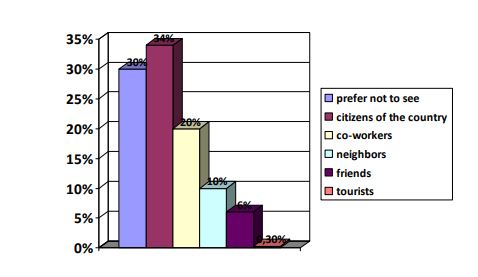
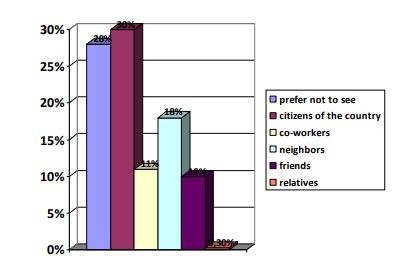
From Figure 6 it follows that sample for the Uighur students tend to perceive the Kazakhs as citizens of the country - 30% preferred not to see - 28%, as colleagues - 11%, as neighbors - 18%, as friends - 10% and 3% as relatives. This characterization as tourists with its expression is not received at all.
According to the requirements of the methodology, we calculated the value of ethnic acceptability.
Group indicator of possible ethnic Uighur students’ admissibility Kazakhs was -0.119, and the real ethnic acceptability is then equal to -0.362, which accounted for 41% of the possible ethnic acceptability. It was a measure of the average negative tolerance, type of social acceptability decision Uighurs at nationals.
According to the requirements of the methodology, we calculated the value of ethnic acceptability.
Group indicator of possible ethnic Uighur students’ admissibility Kazakhs was -0.119, and the real ethnic acceptability is then equal to -0.362, which accounted for 41% of the possible ethnic acceptability. It was a measure of the average negative tolerance by type of social acceptability decision Uighurs at nationals.
Possible ethnic Kazakh students acceptability Kazakhs and Uighur students studying in KazNU totaled 1.00, while the real ethnic acceptability is 0.71, which accounted for 70% of the possible ethnic acceptability, indicating that the adoption representatives of their ethnic group at the level of close relatives, thus demonstrating the Kazakhs and Uighurs to integrate with the representatives of their ethnic group and the establishment of tolerant relations within it.
Consequently, for the respondents Kazakh and Uighur ethnic group most suitable are the representatives of their ethnic sample. Respondents Kazakh and Uighur ethnic groups subjectively preferred social distance from other ethnic groups is very high. They avoid close enough forms of social contact with each other, have a negative attitude to the fact that those were their relatives or family members, or even prefer to see each other less often, but at the same time, they agreed that they were citizens, colleagues, neighbors and friends. The results indicate a desire for isolation and are an indication of tension.
7.Conclusions
Thus, results of the conducted research showed existence at representatives of the Kazakh and Uigur ethnos of a positive orientation on interethnic interaction. However it is impossible to deny existence of separate manifestations of intra group favoritism at the ethnic level, and also existence of interethnic discrimination in some representations in favor of own ethnic group (Stefanenko, 2012).
References
Aymaganbetova O.H. (2010). Socio-psychological study of ethnic tensions in the multiethnic society. Proceedings of the international scientific-practical conference "Kazakhstan's chairmanship in the OSCE: Basic aspects of work on informational support", 33-42.
Pochebut L.G. (2012). Cross-cultural and ethnic psychology. Voronezh: Peter.
Soldatova G.U. (2010). The psychology of ethnic tensions. Moscow: Meaning Stefanenko T.G. (2012). Ethnopsychology. Moscow: Aspect Press.
Copyright information

This work is licensed under a Creative Commons Attribution-NonCommercial-NoDerivatives 4.0 International License.
About this article
Publication Date
06 January 2015
Article Doi
eBook ISBN
978-1-80296-001-3
Publisher
Future Academy
Volume
2
Print ISBN (optional)
-
Edition Number
1st Edition
Pages
1-218
Subjects
Educational psychology, education, psychology, social psychology, group psychology, collective psychology
Cite this article as:
Aimaganbetova, O., Sagnaev, T., Balgimbaeva, Z., Bimaganbetova, Z., Naurzalina, D., & Tolegenova, A. (2015). Social and psychological study of interethnic tension in the multiethnic state. In Z. Bekirogullari, & M. Y. Minas (Eds.), Cognitive - Social, and Behavioural Sciences – icCSBs 2015 January, vol 2. European Proceedings of Social and Behavioural Sciences (pp. 172-179). Future Academy. https://doi.org/10.15405/epsbs.2015.01.21

